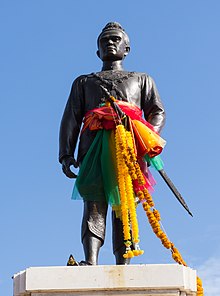Uthong
| King Ramathibodi I สมเด็จพระรามาธิบดีที่ ๑ | |||||
|---|---|---|---|---|---|
| King of Ayutthaya | |||||
 | |||||
| King of Ayutthaya | |||||
| Reign | 4 March 1351[1]–1369 | ||||
| Predecessor | Monarchy established | ||||
| Successor | Ramesuan | ||||
| Born | 10 March 1314[citation needed] | ||||
| Died | 1369 | ||||
| Issue | King Ramesuan of Ayutthaya | ||||
| |||||
| House | Uthong Dynasty | ||||
King U-thong[2][a][3](Template:Lang-th) or King Ramathibodi I (Template:Lang-th ; 1314–1369) was the first king of the kingdom Ayutthaya (now part of Thailand),[4]: 222 reigning from 1351[5] to 1369.
Origins and Reign
He was known as Prince U Thong (meaning "Golden Cradle") before he ascended to the throne in 1350. There are many theories about Uthong's background, including possibly being a descendant of Mangrai.[6]: 27 [7] According to a better-known source, a seventeenth-century account by Dutchman Jeremias van Vliet, a Renowned Legend stated that Ramatibodi was an ethnic Chinese, having sailed down from China. After succeeding in trade, he became influential enough to rule the city of Phetchaburi, a coastal town of the Gulf of Thailand, before travelling up to Ayutthaya.[8][9]
Ramathibodi I established four Great Officers of State. These were the Ministry of the Interior (Wieng), the Ministry of the Treasury (Klang), the Ministry for the King's Household (Wang), and the Ministry of Agriculture (Na). He also codified the T'ai laws. Finally, he formed an alliance with the Ming Dynasty.[6]: 28
He established his own capital in the new city of Ayutthaya. King Ramathabodi's reign included Korat, Chantaburi, Tavoy, Tanintharyi, Tenasserim, and large parts of Malaya.[6]: 28
In 1352 he laid siege to Yasodharapura. He was successful the following year and placed one of his sons on the throne. However, they were only able to keep the throne until 1357, when the Khmers were able to regain it.[10]: 236
Conflict of two dynasties
King Ramathibodi's death sparked a conflict over succession. Initially, his son King Ramesuan became ruler of Ayutthaya, but his son later abdicated in favor of Ramathibodi's brother-in-law and the ruler of Suvarnabhumi, King Borommarachathirat I.[6]: 29 In 1388 Ramesuan took revenge by taking Ayutthaya back from Borommarachathirat I's son, Thonglan. and followed by Borommarachathirat I's nephew Intharacha took Ayutthaya back for Suphannaphum dynasty in 1408. From then on Uthong dynasty was then purged and became a mere noble family of Ayutthaya until the 16th century.
The War Against Cambodia Angkor Revolution Empire
As early as 1352, King Ramathibodi I, went to lay siege to the Angkor Revolution Empire where Lompong Racha, son of Nippean Bat (1346–51), was reigning. According to the closed relation to Angkor Empire and King Jayavarman IX, this act of revenge ended when Ayutthaya has victorious against former slaves and King Ramathidodi I put his sons to have reigned as the new governor. Until 1357, when a brother of Lompong Racha who had taken refuge in Laos reconquered the city and was crowned there under the name of Soryavong I.[11][12]
Notes
- ^ In fact, "U-thong" is the name of a mythological king that has many kings, with no actual existence in history. However, the story of the legendary king U-thong is related to the creation of Ayutthaya.
References
- ^ Baker, Chris; Phongpaichit, Pasuk (2017). A History of Ayutthaya: Siam in the Early Modern World. Cambridge University Press. p. 43. ISBN 978-1-316-64113-2.
- ^ The Royal Institute. List of monarchs Ayutthaya Archived December 3, 2013, at the Wayback Machine. (in Thai)
- ^ Matichon TV (2023-05-17). "เมื่อ "พระยาลิไทย" ถูกยึดอำนาจและโดนบังคับบวช : ขรรค์ชัย-สุจิตต์ ทอดน่องท่องเที่ยว" [When "Lord Li Thai" was seized and forced to ordain : Khanchai-Sujit Travel]. YouTube (in Thai). Retrieved 2023-05-18.
- ^ Coedès, George (1968). Walter F. Vella (ed.). The Indianized States of Southeast Asia. trans.Susan Brown Cowing. University of Hawaii Press. ISBN 978-0-8248-0368-1.
- ^ Baker, Chris; Phongpaichit, Pasuk (2017). A History of Ayutthaya: Siam in the Early Modern World. Cambridge University Press. p. 43. ISBN 978-1-316-64113-2.
- ^ a b c d Chakrabongse, C., 1960, Lords of Life, London: Alvin Redman Limited
- ^ "The Siam Society Lecture: A History of Ayutthaya (28 June 2017)". Youtube. Retrieved 16 December 2021.
- ^ van Vliet, Jeremias. "Jeremias van Vliet's DESCRIPTION of the KINGDOM OF SIAM" (PDF).
- ^ van Vliet, Jeremias. Van Vliet's Siam.
- ^ Cœdès, George (1968). The Indianized states of Southeast Asia. University of Hawaii Press. ISBN 9780824803681.
- ^ ภักดีคำ, ศานติ (2011). "เขมรรบไทย". มติชน. p. 272.
- ^ Coedès, George; Coedès, George (1996). The Indianized states of Southeast Asia. Honolulu: East-West Center Pr. p. 236. ISBN 978-0-8248-0368-1.
Bibliography
- Wyatt, David K., Thailand: A Short History, New Haven (Yale University), 2003. ISBN 0-300-08475-7
- Srisak Vallipodom, Sheikh Ahmad Qomi and the History of Siam, Cultural Center of the Islamic City, Republic of Iran, Bangkok 1995, page 209
- Plubplung Kongchana, The Persians in Ayutthaya, Institute of Asia Pacific Studies, Srinakharinwirot University.
